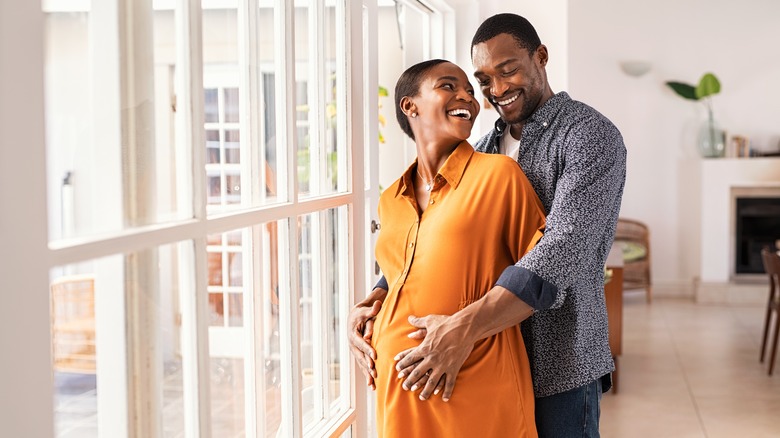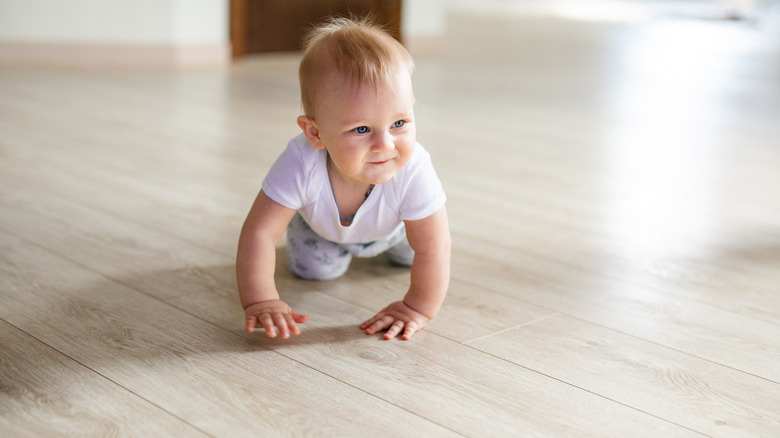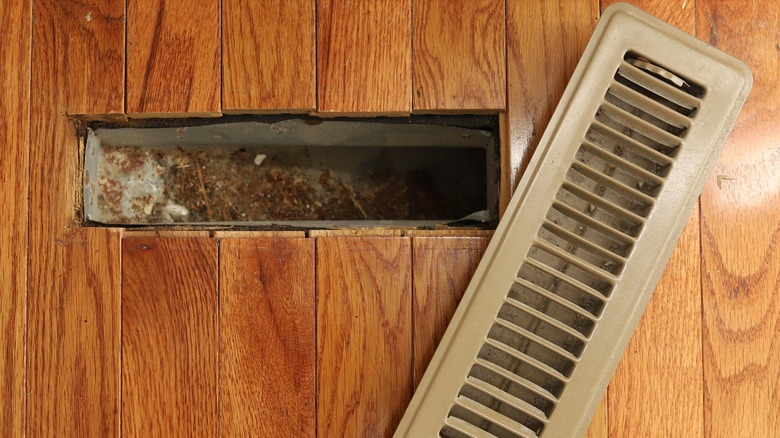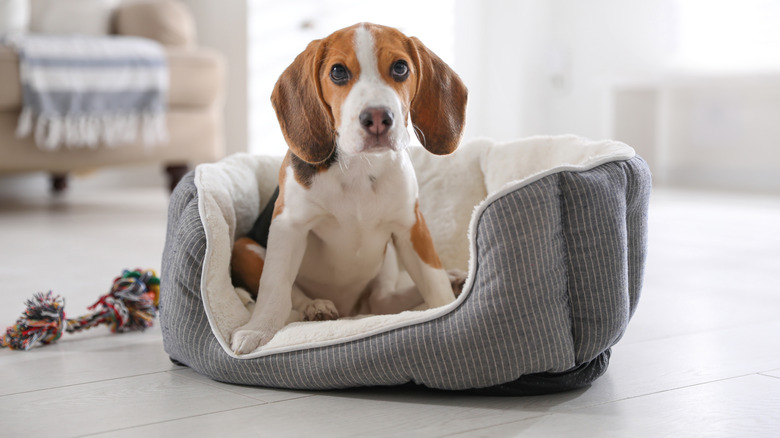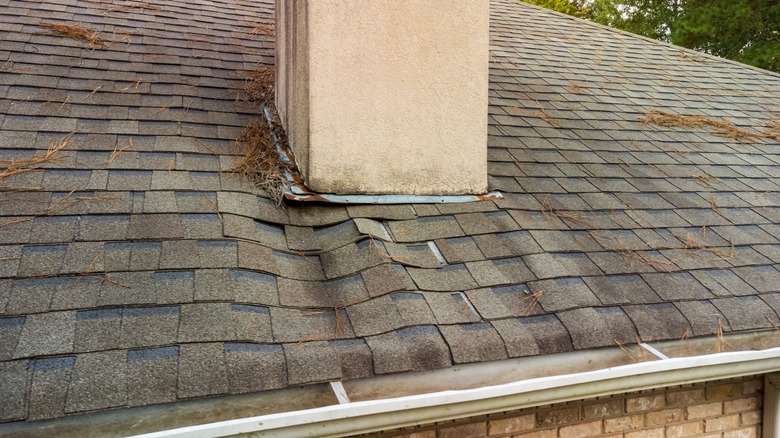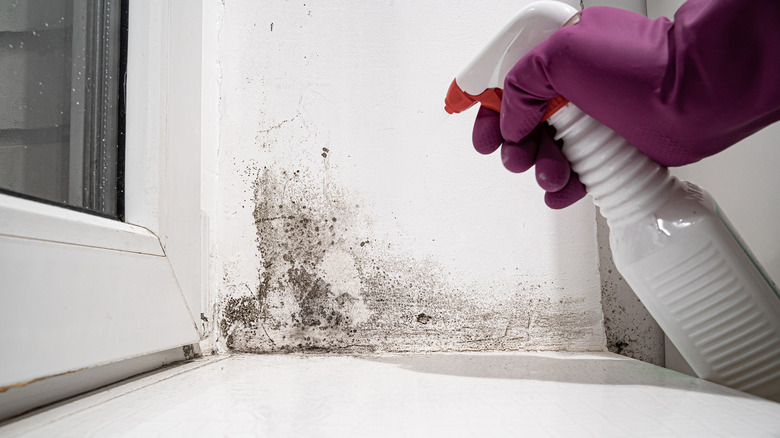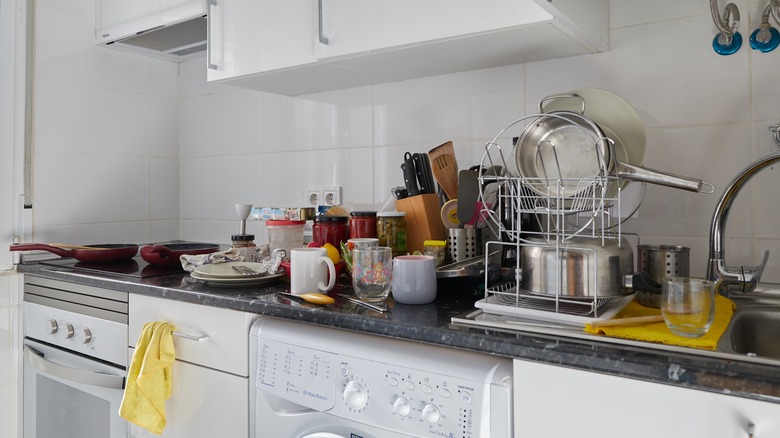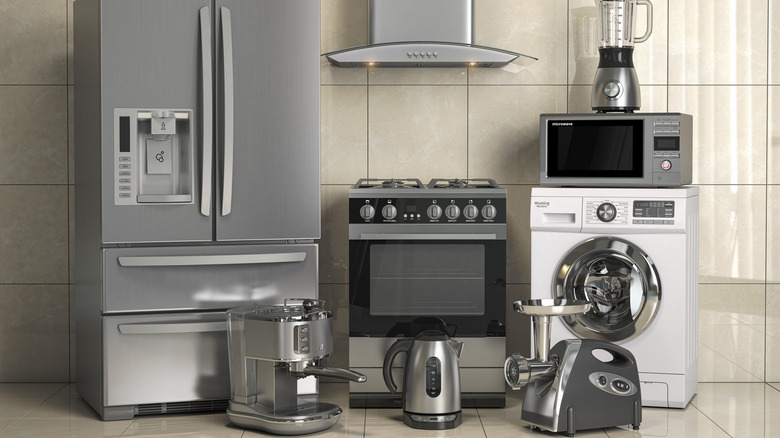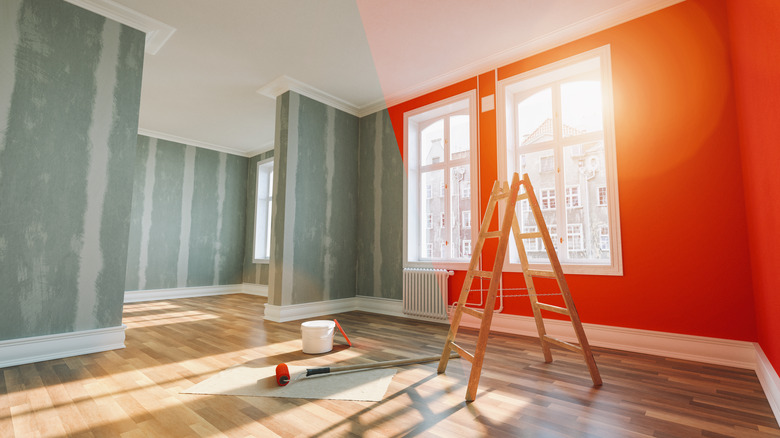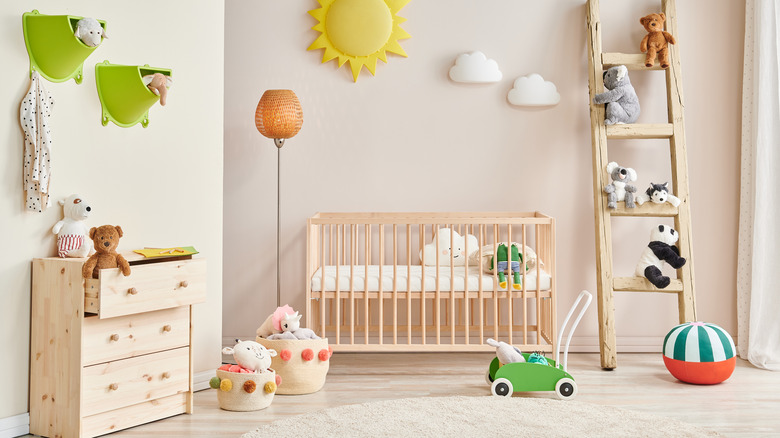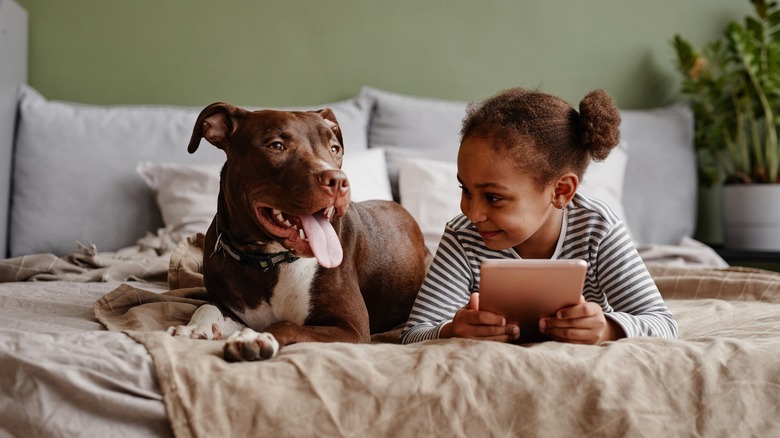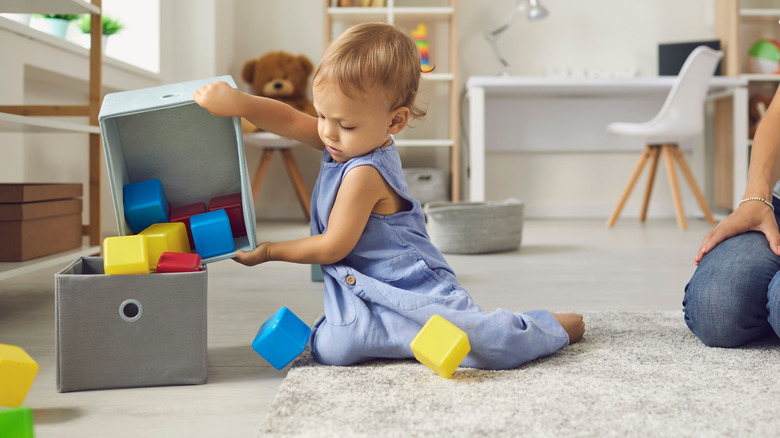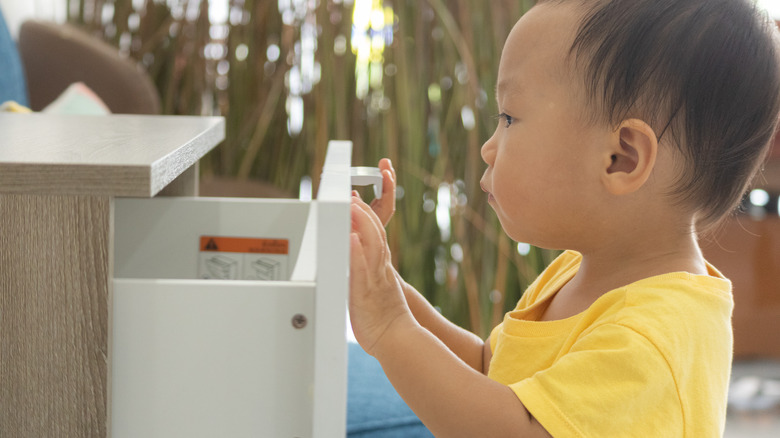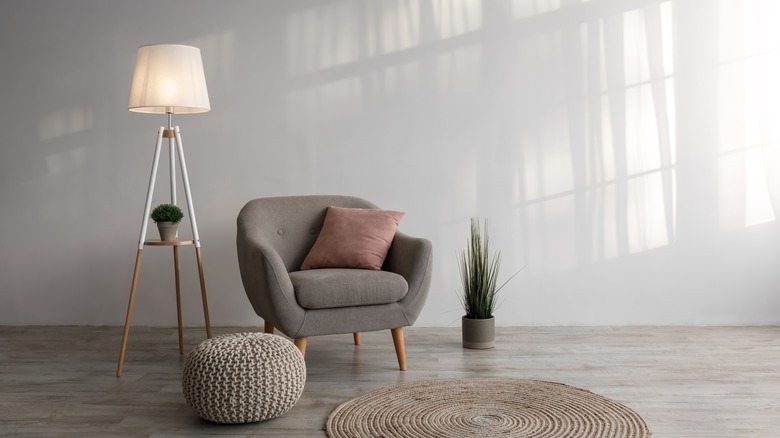Important Home Improvements To Make If You're Expecting
Having a baby is an exciting time! Whether this baby is your first or joining other siblings, it's helpful to have home improvements complete before the big day. Thankfully, according to What to Expect, your body naturally goes into "nesting mode" during the last few weeks of pregnancy, and you'll feel like tackling home improvement projects.
There are plenty of reasons to complete projects at home before the baby arrives, but the most important one is the fact that safety is of utmost importance with little ones. They can't protect themselves, so the home needs to be as safe as possible. Sure, your little newborn can't roll over yet, and certainly is months away from crawling. This might make you think you still have months, if not an entire year, before you have to babyproof things. However, once you're busy with a baby, the time will fly, and suddenly you'll be wishing you would have tied up the loose ends of home improvement projects. Here's what to finish before your due date.
Consider new flooring
From sitting to crawling to taking their first steps, your new love needs the right flooring as they explore their new world. If your floors have seen better days, take care of them or replace them before the baby comes home. If you have carpeting in your home, it might be hiding more than a few coffee stains. The American Lung Association explains that carpets may hold dust mites, mold, pet dander, and even pollution. At the least, get your carpets professionally cleaned. An excellent alternative to carpets is vinyl plank flooring. Floor Coverings International writes that vinyl plank flooring is budget-friendly, durable, and easy to maintain. It's also scratch resistant which is perfect when the baby becomes a toddler who loves to practice throwing toys.
If you have beautiful wood floors, you're in luck. They don't hold on to things the way carpet does; however, they can be dangerous if not taken care of. Through the years, splits and cracks might occur, leaving sharp edges and splinters of wood that can hurt your baby. If that's the case with your wood floors, get them sanded down and refinished so they're smooth. Or, if possible, replace the boards that are in bad shape. Even if your wood floors are in perfect condition, consider some rugs so the baby has a soft place to lay down, play, and practice their first "rollover."
Clean your vents and air ducts
If you don't like dusting now, surely you won't like it once the baby arrives. Dusting is time-consuming and seems never to end since it constantly returns. There's no avoiding dust, and one place it loves to collect is in your vents and air ducts. That means every time the furnace runs, dust is blown into the house. You'll be doing all you can to make sure the air is safe and clean for your new love, and one easy step to make that happen is by cleaning your vents and air ducts.
It's best to find a professional to clean the air ducts. Our home vacuum cleaners don't do the trick. Professional air duct cleaners get rid of years of built-up dirt and grime, creating greater airflow and cleaner air in your home, per Air Flows Chicago. Once the vents and ducts are clean, you can easily clean the vent grates yourself. According to HVAC.com, after turning off the HVAC system, unscrew the vents and vacuum up debris around the edges. If your vents are plastic, wash them by hand, and if they're metal, run them through the dishwasher.
A space for the pup
Maybe your puppy has been your only baby so far, and with the new baby arriving, there may be some concern about how your favorite pet will handle the new little one. Give your dog a space of its own to escape when needed so they aren't stressed. You'll be glad you did it now rather than waiting until you're in the throes of parenthood.
Most likely, your dog will do great with the baby, as they often feel protective of the new little one. Still, dogs are territorial creatures and need a place to hide when feeling stressed out, per The Dog People. Babies and toddlers can sometimes overwhelm dogs with too much attention. Maybe you have a place in the basement where you can put the dog's crate and toys, or any room in the house where the door can be shut, or at the least, the baby can't get in once they start moving around. Don't feel bad finding a place where your beloved can be alone. We all need our space at times.
Make sure your dog has a soft place in its special room. This could be a rug, a dog bed, or as mentioned, its crate with padding inside. You might even have a couch or chair you could designate for your pet only.
Check on the roof
If the roof needs repair, you don't need to deal with that when you have a newborn. You also don't need to deal with a leaking roof. If you aren't sure, get the roof checked now so that you can take care of it if it needs work. According to Westfall Roofing, several signs make it apparent that the roof needs help: sagging in any area, water damage upstairs, mold or moss on the roof, missing shingles, missing flashing, sky-rocketing energy bills, or a roof older than 20 years.
A healthy roof is necessary for a healthy home. Have a roof inspector look and see how it is doing. If you already know it needs work, it's best to scratch that off your list as one of the first things to improve before the baby comes home. Replacing a roof takes a lot of time and money, and you don't want that kind of stress during the newborn phase.
Make the house mold-free
Some molds are dangerous for little ones to be breathing in. For any of us, certain molds can cause allergic reactions, such as sneezing and watery eyes. For those with asthma, mold is especially dangerous, sometimes triggering an asthma attack.
Many molds are obvious. You might see them in the bathroom or kitchen area. Those can be cleaned using a bleach solution of 1 cup bleach to 1 gallon of water, or simply by spraying the areas with undiluted white vinegar, per Home Depot. To test for mold in your home's air, use a mold testing kit (found at most home improvement stores) or have the home inspected by a professional. Remedies vary if mold is found in this way and usually require professional help since it may be hiding behind walls.
If using a home testing kit, Oh So Spotless suggests preparing the room by closing all the windows and doors for at least 24 hours before testing. After using your testing kit, let it sit still in a dark place for two days before sending it to a lab or determining whether or not there is any mold.
Get the kitchen in working order
Get your kitchen in tip-top shape so you can warm bottles and make quick meals as needed. What does it mean to have a kitchen in working order? It means the items you need are easily accessible, clutter is at a minimum, it's clean, and nothing is broken.
According to Chet's Cleaning, thoroughly clean counters, appliances, cabinets, and floors to prepare your kitchen for the baby's arrival. You'll soon have less time to clean. Make any necessary repairs on cabinets and floors and replace things as needed. If you've been dreaming of painting the kitchen cabinets, do it now. Once the baby arrives, it'll be tougher to get it done. Now is the time to clean out the refrigerator and pantry as well. Make room for new needs, such as formula, bags for freezing breast milk, and a bottle washing station, and get stocked up on snacks and things for the rest of the family. Baskets and bins are a great way to organize your counters and pantry.
Invest in reliable appliances
The laundry stacks up quickly with tiny baby clothes. Dishes seem never-ending because who has time for dishes? When a new member of the family comes home, you need reliable appliances. Sometimes a device can be repaired, and if that's the case, go ahead and make those repairs sooner than later. Otherwise, plan on investing a little cash into the new appliances you need. Your washer and dryer, plus the dishwasher, are priceless when you are busy parents. And, of course, you also want your stove and refrigerator in top-notch condition.
Opt for new appliances that are energy efficient. Energy Star explains that when using energy-efficient appliances at home, your energy bills are lowered. They are sometimes a bigger investment upfront, but worth it in the long run. Devices you can count on bring a lot of relief to new parents. There's nothing better than pressing "start" on a machine and letting it do the dirty work for you. You've got better things to do ... like snuggling a new baby.
Finish up those painting projects
We've all been there — you start a painting project with high hopes of finishing it over a weekend, then suddenly, the days turn into months, and the walls are only half done. Painting when a little one is crawling around is nearly impossible. But is it safe to paint while expecting? It may not be. To be safe, hire a professional painter or have someone else besides you do the painting.
According to BabyCenter, you need to limit your exposure to VOCs no matter who is painting. Ask them to use low VOC paint and ensure windows are open to create better ventilation. If possible, use this time to spend a couple of days with family or friends outside of your home so you can avoid any fumes, just to be safe.
Besides protecting yourself and the baby while the painting project is happening, it's important to have fresh paint before the arrival date, especially if your home is older (specifically built before 1978), due to the risk of lead paint. Toddlers have been known to put the strangest things in their mouths, and lead paint chips can cause damage to babies and young children.
Don't forget the nursery
Babies often spend a few months in the parents' room before switching to their nursery. Still, life is about to get plenty busy, so don't fool yourself into thinking you've got plenty of time to finish the nursery. Eventually, you'll want your bedroom space back, and the baby will also want their space. Kidskintha writes that nurseries are beneficial for all involved. They give babies their own space, which will become a room they feel safe and secure in. It also keeps the house more organized, since you can confine all of their toys, learning aids, and clothes to one room.
Hopefully, you've already chosen a space for the nursery. If so, it's time to get it cleaned, painted, and furnished. Make sure the room is safe, with no cords hanging from windows, and a safe place for the crib, away from anything the baby can reach as they get more mobile. Also, caulk around windows, if necessary, to avoid drafts.
A space for the older kids
If the baby is coming home to siblings, it's important to remember the siblings are about to experience some significant changes. If you haven't already, you may want to consider making a special area for the baby's older sibs. Older children may have confusing feelings when their new sibling comes home. They'll love their brother or sister but may also feel a little jealous or overwhelmed with all the recent changes, per BabyCenter.
A space just for older children doesn't need to be elaborate. It can be a living room corner with a gate around it so the baby can't invade. Or maybe a rec room in the basement if the kids are old enough to be left on their own. Is the dining room being used? If not, maybe it can become a playroom instead. Anything that lets your child know you understand they need some time away from the baby once in a while is helpful. Sometimes all it takes is freshly painted walls, a comfy chair, a rug on the floor, and a few of their favorite things.
Add some extra storage
Can you ever have enough storage? Certainly not. Those little socks, baby toys, and other extras that come with tiny people's territory need a place to live. Make adding extra storage part of your home improvements before the baby arrives. Shelves, baskets, bins, and labels are all helpful for organizing. But what if you live in a tiny space and can't fathom where you could store more? A small home doesn't have to mean a lack of order.
Consider some unusual places, such as under the bed. You can build drawers or simply buy some containers and store clothing, sheets, and blankets under them. Have you looked up lately? How about vertical storage? Adding shelves as high as you like creates instant organizational space. Plus, it's easy to pick up baskets and containers at local stores, then use them to hide the clutter. Get creative and make every corner of the house work for you.
Install locks where needed
Before you know it, your quiet little newborn will be crawling around the house, exploring. Sadly, exploring gets dangerous if things aren't locked up. Putting protective locks where necessary should be number one on your list. No matter how closely you watch your child, accidents can happen if you turn your back for just a moment. StaySafe.org explains that four places in your home need child safety locks: doors, cabinets, appliances, and windows. Any area or object that can be opened and potentially cause harm with objects or poisons must be off-limits to your new love.
Safety locks can be purchased at your local home improvement store or ordered online. Be sure to closely follow the manufacturer's instructions when installing them. Most locks are designed to be baby-proof, but as a parent, you'll still be able to access what you need by opening them.
Ditch the lamps for overhead lighting
Speaking of safety, lamps aren't a wise choice when a baby begins to pull themselves up. The end table in the living room might be utilized as a support system when learning to stand, but the lamp might fall on top of your child. Instead, make overhead lighting a part of your home improvement list.
Lamps pose more risks than being knocked over. We use cords to plug lamps in, so now, not only do you have to worry about the light hurting your baby, but the wires can also cause issues. Your newly walking toddler can easily trip on them. Also, they may become curious and play with the outlet's cord. Not only that, but the lightbulbs in lamps get hot. When a child reaches up to touch the shiny light, they'll get burned.
If you have overhead lighting but use lamps instead, it's a good idea to use ceiling lighting for now until the kids are older. Pack away the lamps for another season. It's best to hire a professional electrician to install your new pendant or chandelier if you don't have any in place.
